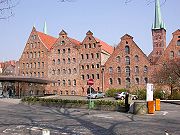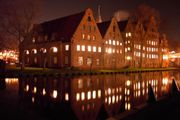
Salzspeicher
Encyclopedia


Lübeck
The Hanseatic City of Lübeck is the second-largest city in Schleswig-Holstein, in northern Germany, and one of the major ports of Germany. It was for several centuries the "capital" of the Hanseatic League and, because of its Brick Gothic architectural heritage, is listed by UNESCO as a World...
, Germany
Germany
Germany , officially the Federal Republic of Germany , is a federal parliamentary republic in Europe. The country consists of 16 states while the capital and largest city is Berlin. Germany covers an area of 357,021 km2 and has a largely temperate seasonal climate...
, are six historic brick buildings on the Upper Trave
Trave
The Trave is a river in Schleswig-Holstein, Germany. It is approximately 124 kilometres long, running from its source near the village of Gießelrade in Ostholstein to Travemünde where it flows into the Baltic Sea. It passes through Bad Segeberg, Bad Oldesloe, and Lübeck, where it is linked to the...
River next to the Holstentor
Holstentor
The Holsten Gate is a city gate marking off the western boundary of the old center of the Hanseatic city of Lübeck. This Brick Gothic construction is one of the relics of Lübeck’s medieval city fortifications and the only remaining city gate, except for the Citadel Gate...
(the western city gate).
Built in the 16th–18th centuries, the houses stored salt that was mined near Lüneburg
Lüneburg
Lüneburg is a town in the German state of Lower Saxony. It is located about southeast of fellow Hanseatic city Hamburg. It is part of the Hamburg Metropolitan Region, and one of Hamburg's inner suburbs...
and brought to Lübeck over the Stecknitz Canal
Elbe-Lübeck Canal
The Elbe-Lübeck Canal is an artificial waterway in Schleswig-Holstein, Germany. It connects the Elbe and Trave rivers, hence constituting an accessway from the Elbe to the Baltic Sea. It is long; the northern terminus is Lübeck, the southern terminus is the town of Lauenburg...
. The salt was then shipped to several ports in the Baltic region
Baltic region
The terms Baltic region, Baltic Rim countries, and Baltic Rim refer to slightly different combinations of countries in the general area surrounding the Baltic Sea.- Etymology :...
, where the commodity was relatively rare, but was in high demand for the preservation of food. The salt trade from the late Middle Ages onward was a major reason for the power of Lübeck and the Hanseatic League
Hanseatic League
The Hanseatic League was an economic alliance of trading cities and their merchant guilds that dominated trade along the coast of Northern Europe...
.
In the course of the centuries, the houses were adapted for the storage of different goods, such as cloth, grain and wood.
Part of the complex was used as the residence of Count Orlok in the classic horror movie Nosferatu, eine Symphonie des Grauens
Nosferatu, eine Symphonie des Grauens
is a classic 1922 German Expressionist horror film, directed by F. W. Murnau, starring Max Schreck as the vampire Count Orlok...
.

